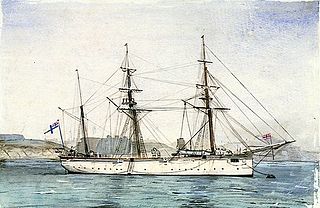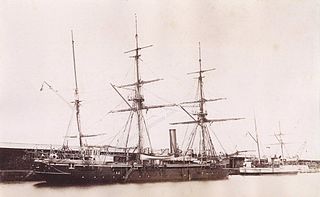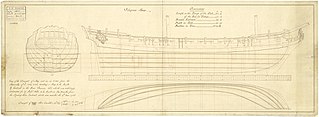The following ships of the Royal Navy were assigned the name Calypso, after Calypso, a sea nymph in Greek mythology:

HMSGannet is a Royal Navy Doterel-class screw sloop-of-war launched on 31 August 1878. It became a training ship in the Thames in 1903, and was then loaned as a training ship for boys in the Hamble from 1913. It was restored in 1987 and is now part of the UK's National Historic Fleet.

HMS Algerine was a Phoenix-class steel screw sloop of the Royal Navy. She was launched at Devonport in 1895, saw action in China during the Boxer Rebellion, and later served on the Pacific Station. She was stripped of her crew at Esquimalt in 1914, and transferred to the Royal Canadian Navy in 1917, being commissioned as HMCS Algerine. She was sold as a salvage vessel in 1919 and wrecked in 1923.
Three ships of the Royal Navy have been named HMS Melita, named after the island of Malta:
Twenty-two ships of the Royal Navy have borne the name HMS Falcon. They are named after an exceptionally fast bird of prey.

HMS Reindeer was a Royal Navy Mariner-class composite screw gunvessel of 8 guns.

The Mariner class was a class of six 8-gun gunvessels built for the Royal Navy between 1883 and 1888. Four were built in the Naval Dockard at Devonport, and two elsewhere; the Acorn was built by contract at Jacobs Pill on the Pembroke River, while the Melita was built in the Malta Dockyard, the only substantial ship of the Royal Navy ever to be built in the island.

HMS Mariner was the name-ship of the Royal Navy Mariner-class composite screw gunvessel of 8 guns.

HMS Racer was a Royal Navy Mariner-class composite screw gunvessel of 8 guns.

HMS Icarus was a Mariner-class composite screw gunvessel of 8 guns, and the third Royal Navy vessel to carry the name. She was launched in 1885 at Devonport and sold in 1904.
Seven ships of the Royal Navy have borne the name HMS Ringdove, another name for the common wood pigeon:
HMS Swift has been the name of numerous ships of the Royal Navy:

HMS Phoenix was a 6-gun steam paddle vessel of the Royal Navy, built in a dry dock at Chatham in 1832. She was reclassified as a second-class paddle sloop before being rebuilt as a 10-gun screw sloop in 1844–45. She was fitted as an Arctic storeship in 1851 and sold for breaking in 1864.

HMS Rambler was an Algerine-class gunvessel of the Royal Navy, built by John Elder & Co., Glasgow and launched on 26 January 1880. She was commissioned as a survey vessel in 1884 and served in Chinese waters during the 1880s and 1890s. She provided men to a naval brigade during the Boer War and was sold on 23 January 1907. The work of this vessel is now remembered in Hong Kong by the Rambler Channel near Tsing Yi.

The Algerine-class gunvessel was a class of three Royal Navy composite gunvessels built in 1880. Two of them were sold after only ten years of service, but the other was converted to a survey ship before commissioning and survived in this role until 1907.

HMS Ringdove was a Redbreast-class gunboat of the Royal Navy, built at Devonport Dockyard and launched on 30 April 1889.

HMS Stork was a 10-gun Alderney-class sloop of the Royal Navy which saw active service during the Seven Years' War. Launched in 1757, she was assigned to the Navy's Jamaica Station until August 1758 when she was captured by the French. She remained in French hands until being disarmed in 1759 and removed from service in 1760.

HMS Diligence was a 10-gun Alderney-class sloop of the Royal Navy which saw active service during the Seven Years' War and the American Revolutionary War. Launched in 1756, she was a successful privateer hunter off the coast of France before being reassigned to North American waters in 1763. Fifteen years later she was briefly refitted as a receiving ship for press ganged sailors brought into Sheerness Dockyard, before being re-registered in August 1779 as the fireship Comet.

HMS Desperate was originally slated to be built to the Sampson designed steam vessel rated as a Steam Vessel First Class (SV1); however, the Admiralty, first rerated the vessels as First Class Sloops on 19 April 1845 then on the 9 May 1845, she was ordered as First-Class screw sloops to be built from a design of Sir William Symonds, Surveyor of the Navy. She would be a 10-gun vessel with 400 NHP engines. She served in the Baltic during the Crimean war, and as a store ship to Edward Augustus Inglefield's Arctic expedition. She was broken up by 1865.













